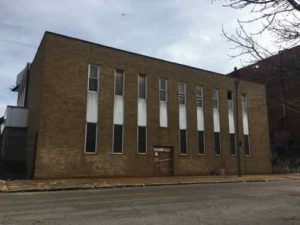 Mill Creek, a vibrant African-American neighborhood, destroyed by Urban Renewal, is one of my favorite St. Louis subjects. So when the publisher contacted me for a review copy of ‘The Last Children of Mill Creek’ I quickly said yes.
Mill Creek, a vibrant African-American neighborhood, destroyed by Urban Renewal, is one of my favorite St. Louis subjects. So when the publisher contacted me for a review copy of ‘The Last Children of Mill Creek’ I quickly said yes.
A true story of growing up in segregated St. Louis, The Last Children of Mill Creek is the debut memoir by a talented writer finding her authentic voice later in life.
Vivian Gibson is a native St. Louisian who grew up in Mill Creek Valley, a neighborhood of St. Louis razed in 1959 to build a highway. Her family, friends, church community, and neighbors were all displaced by this act of “urban renewal.” In this moving memoir, Gibson recreates the everyday lived experiences of her large family, including her seven siblings, her crafty college-educated mother, who moved to St. Louis as part of the Great Migration, and her at-times forbidding father, who worked two jobs to keep them all warm and fed. With an eye for telling detail, she sketches scenes populated by her friends, shop owners, teachers, and others who made Mill Creek into a warm, tight-knit, African-American community, and reflects upon what it means that Mill Creek was destroyed in the name of racism disguised as “progress.”
The Last Children of Mill Creek is a moving memoir of family life at a time very different from the modern-day, when many working-class African-American families did not have indoor plumbing and when sundown laws were still in effect—and a document of an era that is now often forgotten or denied. In Gibson’s words, “This memoir is about survival, as told from the viewpoint of a watchful young girl —a collection of decidedly universal stories that chronicle the extraordinary lives of ordinary people.” (Belt Publishing)
A family memoir isn’t the usual type of book I’d look at on this blog. It only has one photo, a family photo of a mom reading to kids. No photos of buildings, no maps or charts. Gibson does mention their neighborhood being vacated and razed, but only to provide context.
I’m very glad I didn’t turn it down.
I usually just scan books, but this book I read cover to cover. Yes, it’s a short book — but it still took me a week (post-stroke reading is a challenge for me). Gibson does a wonderful job of introducing the reader to her family and their home that was at 2649 Bernard Street. In doing so she also describes the Mill Creek neighborhood.
Gibson lived with her parents and seven siblings in a 3-room cold-water flat, her paternal grandmother lived alone in the upstairs flat. Yes, a family of 10 lived in just three rooms. Well, her brothers stayed in the basement. Their flat was basically beds and a kitchen. A single light bulb per room. And rats.
With overcrowding into flats lacking hot water, but with plenty of rats, Mill Creek was a slum, right? No, Gibson’s descriptions of her street, neighborhoods, businesses, churches, schools, etc. is of a wonderful tight-knit neighborhood.
Once the current pandemic is over I want to meet Gibson to ask her more about the buildings, blocks, and businesses. In the meantime I’m going to start reading the book again, taking note of the many details she does give. I’d like to see another book — or a film — about the neighborhood.
Many of you likely saw The Pruitt-Igoe Myth, about the failed high rise public housing project. I think someone needs to do a film/documentary about life in neighborhoods a generation before they were razed. Mill Creek is a good place to start.
Gibson’s book beautifully describes life growing up in Mill Creek, it saddens me it was physically erased. I can’t recommend this book enough, very enjoyable. I’ve spent many more hours thinking about it than reading it.
— Steve Patterson
b
b
b




 Mill Creek, a vibrant African-American neighborhood, destroyed by Urban Renewal, is one of my favorite St. Louis subjects. So when the publisher contacted me for a review copy of ‘The Last Children of Mill Creek’ I quickly said yes.
Mill Creek, a vibrant African-American neighborhood, destroyed by Urban Renewal, is one of my favorite St. Louis subjects. So when the publisher contacted me for a review copy of ‘The Last Children of Mill Creek’ I quickly said yes.